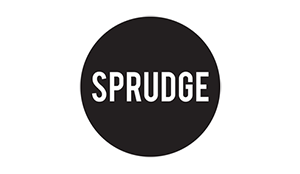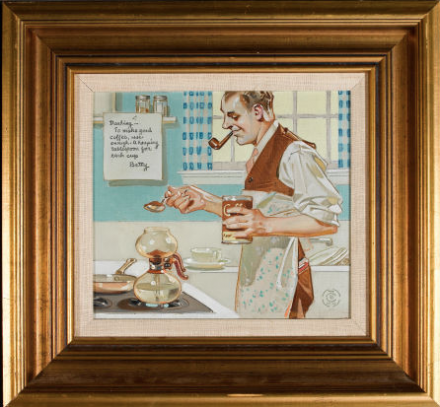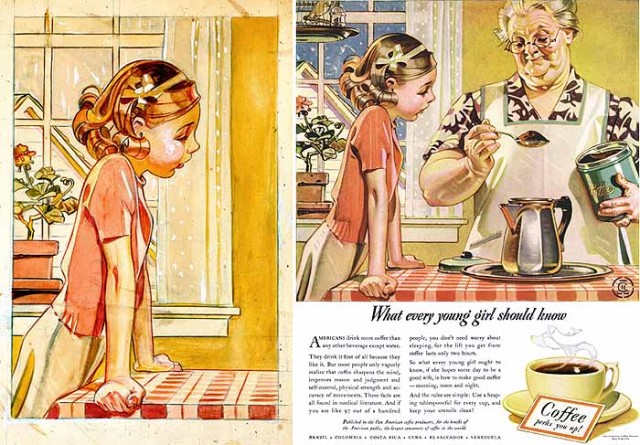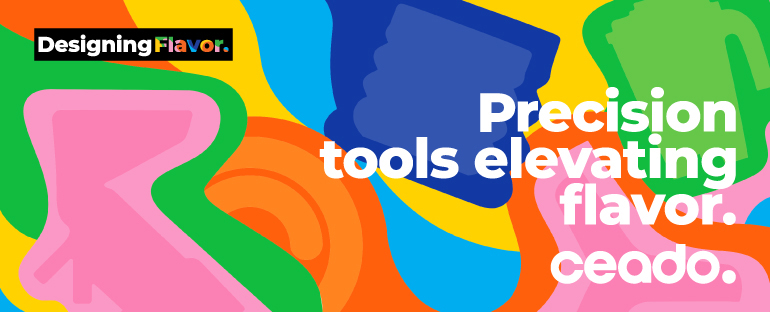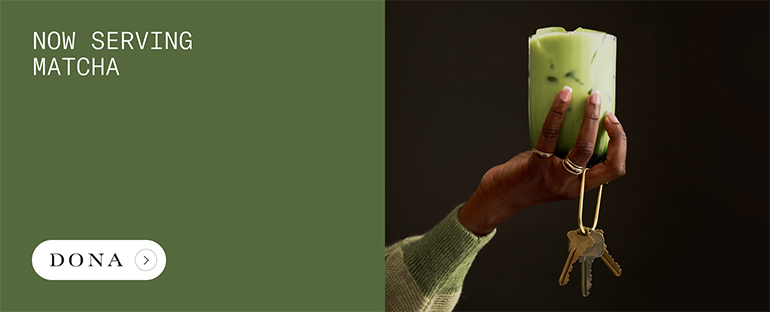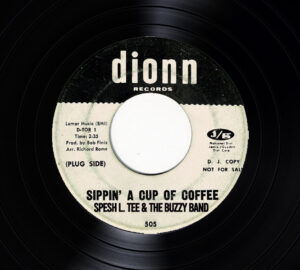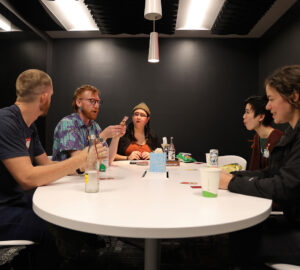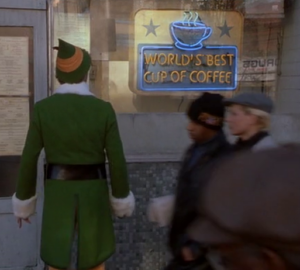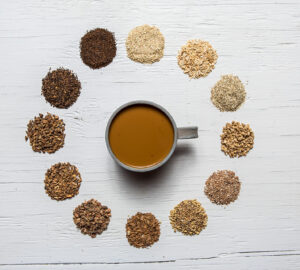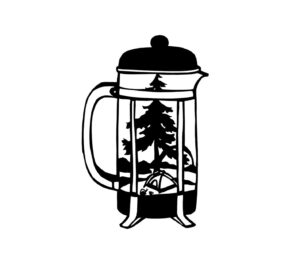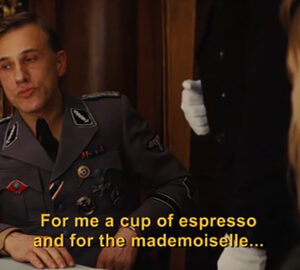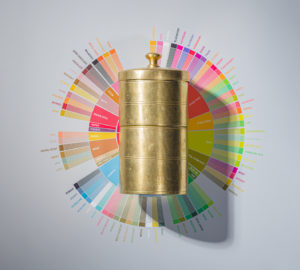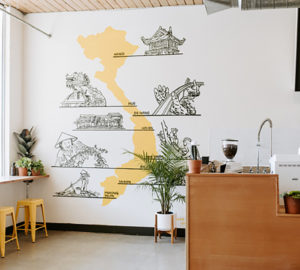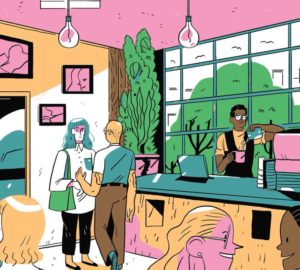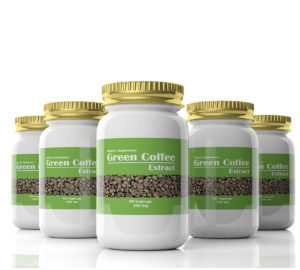When we talk about coffee, we try to square away a narrative. This coffee chronicle unfolds in books like Left Coast Roast: A Guide to the Best Coffee Roasters from San Francisco to Seattle or in illustrations like the one you see above, which is Joseph Christian Leyendecker’s Recipe for Coffee. Both pieces ask the question, “What does a morning cup of coffee look like in America?” And both, in trying to hobble an answer, scratch the surface of a more crowded question: What is an American cup of coffee?
For Leyendekcer, an American cup of coffee is domestic. The ritual, the cup, is prepared by the woman. Details like water to coffee ratios are shaped by the woman, left in a letter for the husband, and the whole ceremony is associated with an apron, a kitchen, and a metal can of coffee.
This isn’t far from what I remember. I grew up with coffee words like “rich” and “dark,” and the leftover metal containers were where my folks hid family heirlooms—my grandparents’ wedding rings, some $2 bills and Kennedy half dollars my father thinks will accrue in value, even important papers like wills went into coffee tins. Putting family relics in coffee tins made sense because the coffee tin was ubiquitous to the American household. Nobody would think twice about a coffee tin in a pantry, nobody would think to look inside of it. For my family, this was American: coffee tins in the pantry.
But each attempt to lace up an American narrative faces a border problem. More accurately, it faces the dilemma of borders being kind of lame, unreal little fantasies. Let’s get this out of the way; in most cases, borders do not make sense. We construct a lot of stuff that makes a border seem like it makes sense—we vote on national languages, we assign food to certain cultures, and we put a generalized culture on top of variant and vibrant cultures. Sometimes, coffee plays a role in these apparitional borders. In a real way, coffee faces economic, social political, and national borders regarding place of origin and place of consumption and profit. I want to talk about that, but I’m pretty sure that’s a frenemy-making conversation or, at least, a conversation that needs a few beers. I’m keeping it a bit more cursory. I’m talking about the superficial coffee borders like taste preference: in Venezuela they prefer dark roasts, the French like robusta, and so forth. While there’s validity to regionalism and regional preferences, there are overlaps and anomalies, there are frays in the clean borders we want to believe in.
One of the frays, for a conversation about an American cup of coffee, is immigration. Since some borders, fictive or not, are thick, coffee was sometimes used to “make” someone American. At least, it was able to give the effect of being American. Coffee was kind of a costume for some immigrants; everyone had coffee in America and an immigrant could be just like everyone else with a cup of coffee. For my great grandparents, drinking coffee in the morning the same way that everyone else drank coffee in the morning was a consistent calm in an otherwise difficult transition from the old country.

For my great-grandma Catherine, a cup of coffee was like role-playing. She played the typical American woman who woke up before her husband, started the hot water, and got the coffee ready before he woke up. As my mother remembers it, “It was a white porcelain coffee pot. It was always on the stove, always on the back burner, but nobody ever saw Catherine actually make the coffee because it was done before her husband, her brothers, anyone knew they wanted it.” The cultural value of the white porcelain pot is immeasurably important, as it fixed her and her family in the tradition of other Americans. It posited her as at least “somewhat the same.”
For Catherine, seeking to be at home in America was an impossible position. Catherine, like most immigrants, wondered “How do I participate?” And the answer was to keep some rituals, to make coffee in the morning, and go about her day with the discipline to forget feeling alone. A simple cup of coffee was a way to make order out of her dislocation and distress. But the social articulation of her American performance was incomplete. As she negotiated her cultural baggage with the white porcelain coffee pot, she only gestured to what other American woman were doing. What was familiar for Catherine was the kitchen. The full flush of standing over a stove, the prattle of pots, and the stirring of a spoon. Catherine took to kettle and water, took to the common ancestry of pots of stew, sliced potatoes, and cups of coffee.
Here’s the paradox: it was coffee that kept her grounded and coffee that exposed her identity as an outsider. Unlike the other apron-clad women, Catherine took her coffee with an egg.
This might not have been cultural. Travelers to Minnesota have no doubt heard of “Swedish gasoline” or Swedish coffee. The first is for a crowd: fill ten cups of a coffeepot with water and boil. Mash together ten tablespoons of ground coffee with one egg yoke to make a paste. When the water boils, add the coffee/egg mash to the pot and simmer until the grounds sink to the bottom. The resulting drink has less perceived acidity and the egg seems to cut the bitterness. You’ll see this drink advertised in rural Minnesota, Iowa, and parts of Indiana.
I doubt adding an egg is an homage to classic cocktails, although my father insists egg was added to everything back then and he says that, at the Moose Lodge, they still throw an egg in your beer. I doubt this is even, as advertised, purely Swedish in origin. I’ve seen the same recipe with a dollop of ice cream added to the mug, which transforms “Swedish gasoline” to a “Lutheran Latte.” If anything, these variations seem Midwestern. You can find countless anecdotes of cowboy coffee (shells only), Scandinavian or Norwegian egg coffee (same as the Swedish variation), and some will claim that the egg clarifies the coffee, but it’s probably just that the grounds settle on the bottom of the pot because they adhere to the egg fat and protein instead of floating around in your white mug and mucking it all up.
In some places, like Catherine’s kitchen, the egg shell itself is thrown in. According to Catherine, this was for calcium and protein. Unlike the Swedes, Norwegians, and other egg coffee-aficionados, Catherine was using the egg to fend off starvation. She was also, I’m told, convinced the heavier coffee grounds (heavy from the egg) cleaned the sink. Everything, to her, had to serve more than one purpose and coffee was no exception.
Catherine was in a precarious position, a middle ground between assimilation and separation. It’s because of this that she called her coffee “coffee”—without an attached origin or description. Calling it coffee let her fit in and become American. Adding an egg, shell and all, let her keep an attachment to the traditions of her past and gave her the strength to bear the complexity of the immigrant experience. The egg here is a cultural object: it’s Catherine and her family needing the extra protein to fend off hunger. It’s the memory of leaving a place because you were hungry, hoping to find food and not more of your already visible ribcage in America.
There’s variation and those variations reveal that this is a performance of the American morning ritual and that the American morning ritual itself is probably false, probably a fuzzy little fantasy that has more incongruities than regularities. The border of what is and what is not American mattered to Catherine, it mattered to a lot of immigrants and it still does. This is how coffee is about gathering, how coffee is really about bringing people together—it is a ritual we can share in spite of our individual heritages. It was, and might still be, an easy entry point to inclusion.
We don’t talk about coffee this way, as something that actually gets us through the day to day, gets us through a sense of exile or displacement. We romanticize the cup and the ritual so much, but for many cultural identities (including the coffee farmers and the countries that rely on coffee in an entirely different way than our own country) the morning cup of coffee is a genuine site of access, a real entry point to being, like coffee, commonplace and accepted.
There’s a scene in the documentary Stranger With A Camera where an Appalachian family is getting ready for a day of mining and hard labor. The mother is asked, after giving her husband and children breakfasts, what she’ll be having for breakfast. She holds up her cup of coffee and fingers her cigarette, showing that these two items are her breakfast. It’s certainly not the Folger’s scene we’re used to seeing in commercials or the third wave appreciation for the origin, roast, and flavor notes. It’s less of an attempt to express the world and more of a way of being in the world. In the ordinary world, people want to belong and get through the efforts to belong.
Why does this matter? It matters because stories matter. There’s the simple coexistence of things and phenomena: the cup of coffee, the white porcelain pot is happening at the same time of a great unsettling and a great exertion to be normal. Catherine’s American day begins brightly with egg coffee, but the sun sets after the cup and after the pervading reality of being Other sets back in.
Things are even more confused than this narrative suggests—we’re leaving out the story of how the product even got to Catherine’s pot—but Catherine’s story illustrates the value of domestic rituals, things as simple as coffee, for how they trouble difficult boundaries and enable crossing. Catherine’s story roots the romantic and idyllic story we tell ourselves about coffee and coffee shops. It’s over a cup of coffee that we can ask people, “I want to know what you think.” It’s over a cup of coffee that we can transgress and share.
If you’re interested in a more proper recipe, Ritual Roasters has a demo of egg coffee, which you can watch here. Even though the barista chides, “Just like Grandma used to make,” it’s a little different from great-grandma’s recipe. And, obviously, the intent is totally different. I don’t think Catherine was doing this for clear coffee, for less acidity, or for any other taste or aesthetic logic. Instead, this was practical: Catherine left one historical moment, a famine, for another historical moment, immigration and isolation. In the middle of these two miseries, there needed to be sustenance. In the middle of this uprooting and the feeling of disengagement, Catherine needed to feel of substance, full, and heavy. Putting an egg in her coffee meant having enough calories to make it to dinner, and having enough vigor left to keep traversing boundaries.
Kristen Orser-Crouse (@kristen_orser) is an instructor at the University of California – Santa Cruz, with a focus on poetry and Russian literature. She’s contributed to The Rumpus, The Examiner, and Poor Taste, and has written previously for Sprudge on Duende Bodega in Oakland, as a part of our Restaurant Week series.
